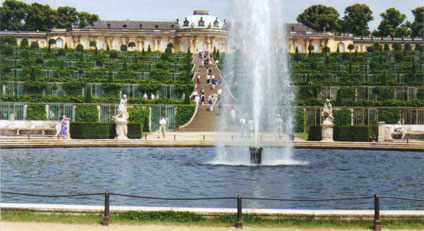Tri-City Herald, Sunday, Sept. 22, 2002
Take a Peek at the 18th Century in Potsdam Near Berlin
©Valerie Kreutzer
 Even if you have only a few days in Berlin, take one to visit Potsdam. The town on the Havel River is only a 25-minute train ride from the center of Berlin, but easily transports you back into the 18th century and Prussia’s golden age.
Even if you have only a few days in Berlin, take one to visit Potsdam. The town on the Havel River is only a 25-minute train ride from the center of Berlin, but easily transports you back into the 18th century and Prussia’s golden age.
The centerpiece of Potsdam is Sanssouci, known as the Prussian Versailles. It was built by Frederick II (the Great) who spent the first part of his reign fighting with Austria, Russia and France, and the second half discussing philosophy with Voltaire and playing chamber music in his charming Rococo castle.
Frederick the Great fancied himself an enlightened ruler, whose principles were challenged, however, when his next-door neighbor, a miller, refused to sell his property to the king. In the end, Frederick respected the man’s rights and the golden castle and grinding windmill have existed side-by-side ever since.
Frederick and his successors dotted the park with chalets, baths, conservatories, and delightful teahouses. Visiting all of them could take several days on a 15-mile loop. Since no cars are allowed, renting a bike is a good solution. And be sure to get a free map for the free park since there are very few signposts.
While Sanssouci and its landmarks were spared, the town of Potsdam was heavily bombed during World War II and much needs to be done to restore it to its former glory. It has helped that Potsdam’s cultural landscape has been placed on the UNESCO World Heritage list.
A special effort has been made to restore the Dutch Quarter, an 18th century settlement of brick buildings, created to accommodate the Dutch craftsmen whom Frederick the Great had invited to work on Sanssoucci. One gabled house has been restored to give visitors a glimpse of the 18th century home life of a tradesman.
Another historic site is the Country Castle Cecilienhof, situated on a lake. In 1945, the victors of World War II negotiated the Potsdam Treaty here. You can visit the rooms where Truman, Stalin and Churchill sat at a round table to draw up the sectors of occupation and the divide between east and west. It took 44 years before the German people tore down this infamous wall of separation.
